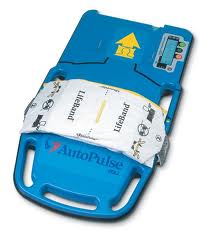AutoPulse

The AutoPulse is an automated, portable, battery-powered cardiopulmonary
resuscitation (CPR) device developed by Revivant and subsequently acquired
and presently manufactured by ZOLL Medical Corporation. It comprises a
constricting band and a half backboard, serving as an adjunct to CPR during
advanced cardiac life support administered by professional healthcare
providers. Known in literature as LDB-CPR (Load Distributing Band-CPR), the
AutoPulse utilizes a distributing band to administer chest compressions.
Before delivering its unique combination of thoracic and cardiac chest
compressions, the AutoPulse measures chest size and resistance. Compression
depth and force vary depending on the patient, with chest displacement
resulting in a 20% reduction in anterior-posterior chest depth. Operating
with a physiological duty cycle of 50%, it offers a choice between a 30:2 or
continuous compression mode, selectable by the user.
During operation, the patient's head, shoulders, and upper back are
positioned on the base unit, with the AutoPulse controls located beside the
patient's left ear. The device can be adapted to provide cervical spinal
support if needed. Housing the control computer, rechargeable battery, and
motors operating the LifeBand, the unit employs an adjustable strap called
the LifeBand, covering the entire rib cage. Upon activation, the LifeBand
tightens around the chest, gauging chest size and resistance before
rhythmically constricting the rib cage, achieving a heart-pumping rate of 80
compressions per minute. Although the LifeBand can be placed over
defibrillation pads, it must be briefly loosened for standard paddle
defibrillation, then repositioned post-shock delivery. Disposable by design,
the LifeBand is intended for single-patient use for hygiene purposes.
The load-distributing band system, incorporating thoracic compressions,
generates higher blood flow compared to CPR employing sternal compressions
alone. The potential to restore blood flow for a sudden cardiac arrest
victim hinges largely on the peak power of the compression, influenced by
compression force, depth, and duration at maximum depth.
While automated CPR machines have demonstrated superiority over manual CPR
in animal studies, translating this success to human research has been less
promising. While some studies observed improved coronary perfusion pressure
and more spontaneous return of circulation with the AutoPulse, a large,
multicentered, randomized clinical trial was halted prematurely by the
Institutional Review Board (IRB). The decision was based on the finding that
patients receiving manual CPR were more likely to leave the hospital
walking, indicating that further investigation is warranted to determine
factors beyond the device's mechanical capabilities that influence its
effectiveness.
undo Medical Equipment